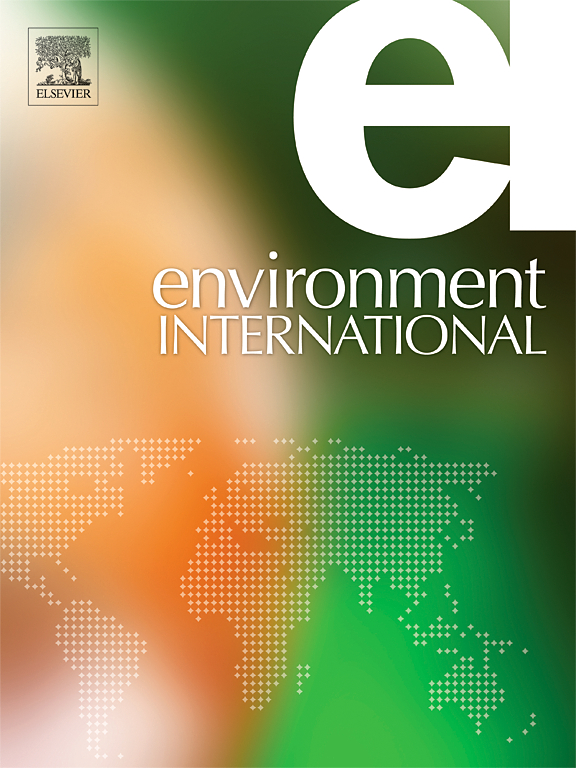From microbiota to metabolism: Unveiling the hidden ecological threat of galaxolide (HHCB) to zebrafish through aquatic microcosm
IF 10.3
1区 环境科学与生态学
Q1 ENVIRONMENTAL SCIENCES
引用次数: 0
Abstract
The widespread use of Galaxolide (HHCB) and its environmental persistence and bioaccumulation potential pose risks to both the environment and living organisms. This study integrates an innovative aquatic microcosm experimental platform with multi-omics techniques to explore the ecological toxicity of HHCB, simulating aquatic ecosystems and assessing its impacts on zebrafish. The results indicate that HHCB, whether at environmentally relevant concentrations (0.1, 2.5 μg/L) or at higher levels (62.5 μg/L), significantly alters the diversity and composition of the zebrafish gut microbiota, suggesting that HHCB may promote more complex interactions within microbial communities. HHCB also induces metabolic disturbances in the zebrafish gut, significantly affecting multiple metabolic pathways. Moreover, this impact exhibits a dose-dependent effect, with higher concentrations of HHCB leading to more pronounced disruptions. Integrated analysis reveals a notable correlation between gut microbiota and metabolites. Gene set enrichment analysis (GSEA) further suggests that HHCB may drive dynamic changes in microbial ecological functions by disrupting microbial metabolic processes, thereby increasing the risk of metabolic imbalance. This study suggests that HHCB induces metabolic disorders in zebrafish through its multiple effects on gut microbiota and metabolic functions. By leveraging the aquatic microcosm approach, the study offers a more realistic simulation of environmental conditions, providing critical insights into the mechanisms by which HHCB affects gut microbiota and metabolism in aquatic organisms. The findings contribute new scientific evidence for assessing the ecological risks of environmental pollutants.


从微生物群到代谢:通过水生微生物揭示galaxolide (HHCB)对斑马鱼的潜在生态威胁
Galaxolide (HHCB)的广泛使用及其环境持久性和生物蓄积潜力对环境和生物都构成了风险。本研究将创新的水生微观实验平台与多组学技术相结合,探索HHCB的生态毒性,模拟水生生态系统,评估其对斑马鱼的影响。结果表明,无论是环境相关浓度(0.1、2.5 μg/L)还是更高浓度(62.5 μg/L), HHCB都能显著改变斑马鱼肠道微生物群的多样性和组成,表明HHCB可能促进微生物群落内部更复杂的相互作用。HHCB还在斑马鱼肠道中诱导代谢紊乱,显著影响多种代谢途径。此外,这种影响表现出剂量依赖效应,HHCB浓度越高,破坏越明显。综合分析显示,肠道微生物群与代谢物之间存在显著相关性。基因集富集分析(GSEA)进一步表明,HHCB可能通过破坏微生物代谢过程来驱动微生物生态功能的动态变化,从而增加代谢失衡的风险。本研究提示HHCB通过对肠道菌群和代谢功能的多重影响诱导斑马鱼代谢紊乱。通过利用水生微观环境方法,该研究提供了更真实的环境条件模拟,为HHCB影响水生生物肠道微生物群和代谢的机制提供了关键见解。这些发现为评估环境污染物的生态风险提供了新的科学依据。
本文章由计算机程序翻译,如有差异,请以英文原文为准。
求助全文
约1分钟内获得全文
求助全文
来源期刊

Environment International
环境科学-环境科学
CiteScore
21.90
自引率
3.40%
发文量
734
审稿时长
2.8 months
期刊介绍:
Environmental Health publishes manuscripts focusing on critical aspects of environmental and occupational medicine, including studies in toxicology and epidemiology, to illuminate the human health implications of exposure to environmental hazards. The journal adopts an open-access model and practices open peer review.
It caters to scientists and practitioners across all environmental science domains, directly or indirectly impacting human health and well-being. With a commitment to enhancing the prevention of environmentally-related health risks, Environmental Health serves as a public health journal for the community and scientists engaged in matters of public health significance concerning the environment.
 求助内容:
求助内容: 应助结果提醒方式:
应助结果提醒方式:


